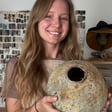
Leveling Up Your Underglaze Illustrations |Caitie North|
In this episode of Shaping Your Pottery Catie North shares her transition from watercolor to pottery, revealing how underglaze techniques can mimic watercolor effects. The conversation covers the intersection of pottery with anime and video game inspirations, and the challenges of creating vibrant, neon-colored glazes. Listeners will learn practical advice on mastering underglaze, the benefits of slip casting, and strategies for promoting pottery on social media. Emphasis is placed on the importance of community, finding one's artistic voice, and the growth stemming from creative collaborations and personal experiences, including insights from a successful partnership with Riot Games. You can learn more about Caitie by checking out her instagram https://www.instagram.com/caitienorth/
Join The Shaping Your Pottery Newsletter By Clicking This Link shapingyourpottery.com/newsletter
For more episodes click here www.shapingyourpottery.com
00:00 Introduction and Newsletter Invitation 00:17 Interview with Catie North: Watercolor to Underglaze 01:39 Catie's Journey into Pottery 03:03 From Watercolor Artist to Pottery Enthusiast 05:39 The Intersection of Watercolor Techniques and Pottery 07:19 Creating Unique Pottery Inspired by Anime and Video Games 12:06 Developing and Teaching Underglaze Techniques 18:13 Common Mistakes with Underglaze 18:29 Exploring Slip Casting 21:23 Transition to Full-Time Potter 24:45 Navigating Social Media for Pottery 27:10 Starting Commissions 28:46 Finding Your Artistic Voice 31:52 The Importance of Community 34:47 Advice for Aspiring Potters 35:56 Conclusion and Where to Find More






